In mid-August the PPP research assistants recognised Michel, one of our collared leopards on the camera traps. We were excited to see him because he hadn’t been photographed for several months and his collar was due to fall off shortly. The GPS collars stay on the animals for 455 days and then drop off automatically. If he is in the area when his collar falls off then we have the best chance of retrieving it and all the data stored on-board.
The good news stopped there. Michel had a snare around his waist. It was cutting into him and would most likely be life-threatening.

The first photo seen of Michel with a snare around his waist
We decided to start trapping in an attempt to catch Michel, remove his collar to retrieve the data, and to have a vet remove the snare. We also hoped to re-collar Michel with a new collar if the vet declared his condition good enough to carry the weight. We moved as quickly as we could and we started pre-baiting immediately in the hopes that Michel would be lured by the bait if he was struggling to hunt. We went to check the cameras on one of the bait stations the day before we opened traps. We found a photograph of him by the bait just 30 minutes before we arrived. We were so near to him we could hear him calling from the bushes!
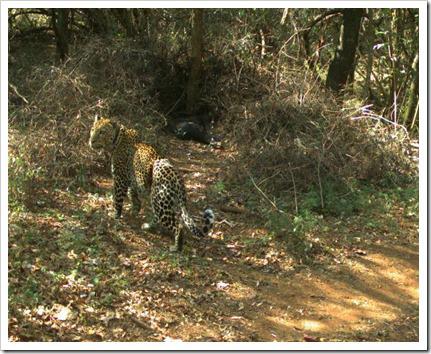
Michel standing by the bait of an unopened trap site just minutes before we arrived.
We got our equipment and tried to download data from his collar but we couldn’t detect a UHF or VHF signal. We were devastated. The data the collar carried would help us to determine where the best place to put the traps were to give us the best chance to catch him, where he picked up the snare, and where he’s been going for the past six months, but the collar wasn’t working right. Now it became even more imperative to catch him to get the collar back and to treat him. If the collar falls off in the bush and it is not emitting a signal, finding the equipment is nearly impossible.
A week and a half into trapping things started happening. While checking traps at night we had two leopard sightings from the car. Leopards were definitely moving in the area! Two leopards, Jenny and Thor, started visiting our trap sites but they weren’t getting caught. Although we were targeting Michel we also were aiming to catch either of these two individuals for GPS collaring. We made some adjustments to the traps so they were definitely ready for the next leopard that came along.
About two weeks into trapping we had our first catch. We found a collared leopard sitting in one of our traps. Could it be Michel?? By that time Michel’s collar was supposed to have fallen off but there was always a chance it stayed on. We were hopeful. It was BB, a young male leopard we collared in July this year. The vet was called because the animal had to be darted to safely release him from the trap. We collected some new data from him and downloaded GPS information from his collar.
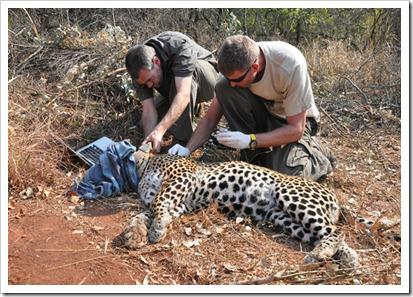
Sam downloads from BB’s collar while Oldrich combs for ticks for parasite analysis.
He was released later in the day. The Earthwatch volunteers were given the amazing opportunity to watch BB run free from the recovery crate after he slept off the drugs.
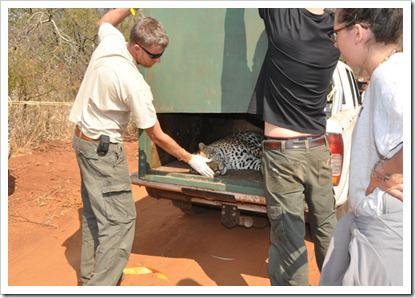
Putting BB in the recovery crate.
Two days after BB’s catch, another trap was triggered. This time it was a brown hyaena. She was sedated and collared for Katy’s PhD research. Her name is Hermione! She was named by a previous Earthwatch volunteer who helped sponsor some of the hyaena study’s research costs. Everything went very well. The best news of all was that Sam was able to track Hermione after her release and download from her collar later that evening. Although this may sound like a small achievement, this was huge for Katy’s research. So far the two collared hyaenas (Chomma and Betton) have been eluding her completely. Now she finally has a lead on where the hyaenas are moving. Even though it’s only a small bit of data, it is a huge step for learning about the elusive brown hyaena in this difficult environment.

Hermione the hyaena!
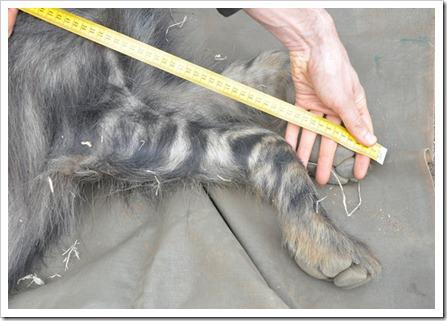
Each brown hyaena his individual leg markings which can be used for identification.
Time was passing and everyone was starting to worry about Michel. He has had the snare on for over a month now. Is he still alive? Is he still wearing the collar? We checked some of the camera traps and found a photograph of him which was taken days before. The collar had fallen off and he looked unhealthy but he’s still in the area and we are still hoping to catch him. We will go and search for the dropped off collar soon.
A few nights ago a trap was trigged by Jenny, a female leopard we were hoping to catch. She was collared and morphological data was taken. We were extremely happy about catching Jenny since the majority of the collar data we have collected thus far has been from male leopards. Collaring Jenny will allow us to find out more about female home ranges and behavior.
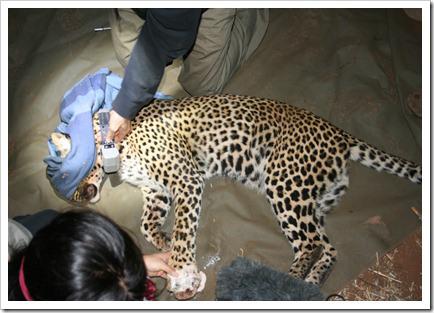
Putting Jenny’s collar on.
The traps will be open every night until this Friday and we still are waiting for Michel, Thor or another brown hyaena to come to the trap sites…
